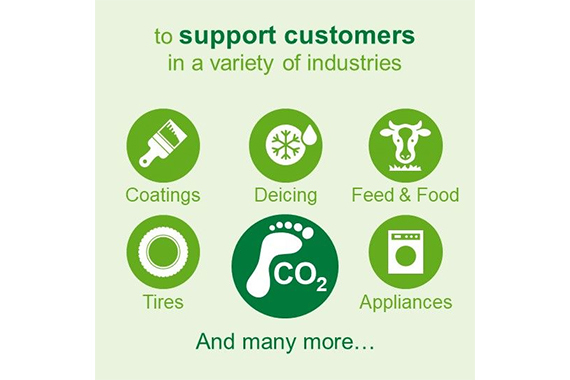More news
- Asian paint regulatory round up – Indonesian exterior paint still uses lead, warns W...
- Nigeria’s paint industry navigates regulatory changes and economic challenges amid p...
- Focus on the global coatings market: Global coatings market outlook
- Innovative coatings mitigate effects of deepening climate change
- Ask Joe Powder – October 2024

BASF has calculated the individual product carbon footprints (PCF) of a large part of its portfolio of chemical intermediates [1]. The results were compared with assessments of market-wide average carbon footprints of the corresponding products of third parties [2]. The outcome of the analysis shows that due to the production set-up the PCF of a range of BASF’s chemical intermediates is significantly below the global average PCF of the corresponding third-party chemicals, all produced from fossil-based raw materials.
BASF now offers these products as "LowPCF” intermediates:
– Tert-Butylamine (tBA) LowPCF
– Formic Acid (FA) LowPCF
– Propionic Acid (PA) LowPCF
– 1,6-Hexanediol (HDO®) LowPCF
– Neopentyl Glycol (NPG) LowPCF
The PCF comprises the total greenhouse gas emissions that occur until the BASF product leaves the factory gate for the customer: from the extraction of resources through manufacturing of precursors to the making of the final chemical product itself. On its journey to achieve net zero CO2 emissions by 2050, BASF is the first large chemical company to make the individual carbon footprints of all its sales products available to its customers.
Various factors contributing to low product carbon footprint
The PCF is determined by various factors. For example, energy generation in BASF’s own gas-fired combined heat and power plants generates significantly less greenhouse gas emissions compared to other conventional energy generation. In addition, production processes of LowPCF intermediates are characterised by high production efficiency in terms of energy and raw material consumption due to BASF’s integrated Verbund system and continuous efforts in operational excellence. Finally, LowPCF intermediates generally use oil, natural gas or Verbund by-products, but not coal, as primary raw materials. Due to its chemical properties, the use of coal generally results in a higher carbon footprint of downstream products compared to natural gas or oil.
"Company CO2 emission reduction targets are playing an increasingly important role in the value chains we serve. With our LowPCF intermediates, we are supporting our customers in achieving their targets: they now have the option to consciously choose a product with a carbon footprint significantly below the global market average,” says Stephan Kothrade, Head of BASF’s Intermediates division. "By making CO2 emission data at the individual product level available to our customers, we also offer a level of transparency that is unique in the chemical industry.”
The intermediates tert-Butylamine (tBA), formic acid (FA), propionic acid (PA), 1,6-hexanediol (HDO) and neopentyl glycol (NPG) are versatile chemicals* that are used as ingredients for numerous everyday products. Examples include plastics, car tires, deicing agents, pharmaceuticals, crop protection products, paints and coatings. BASF customers use these products in the textile, automotive, agricultural, pharmaceutical and furniture industries, among others.
[1] BASF’s product carbon footprint (PCF) calculations follow the requirements and guidance given by ISO 14067:2018. In a methodology review, TÜV Rheinland has certified that the PCF methodology SCOTT developed and used by BASF SE for calculating the PCFs of BASF products is scientifically-based, is in accordance with ISO 14067:2018, and reflects the state of the art (ID-Nr. 0000080389: BASF SE – Certipedia).
[2] BASF has made these assessments of corresponding third-party products using publicly available information and fee-based, proprietary market survey data on production routes and deployed raw materials, to the extent available, as well as BASF’s own market and technology know-how. The data assumptions and allocation factors for third-party PCFs are the same as for the calculation of the PCF of the BASF product, as applicable. BASF’s assessments of the PCFs of the corresponding third-party products have not been subject to an LCA critical review by an independent third party.



